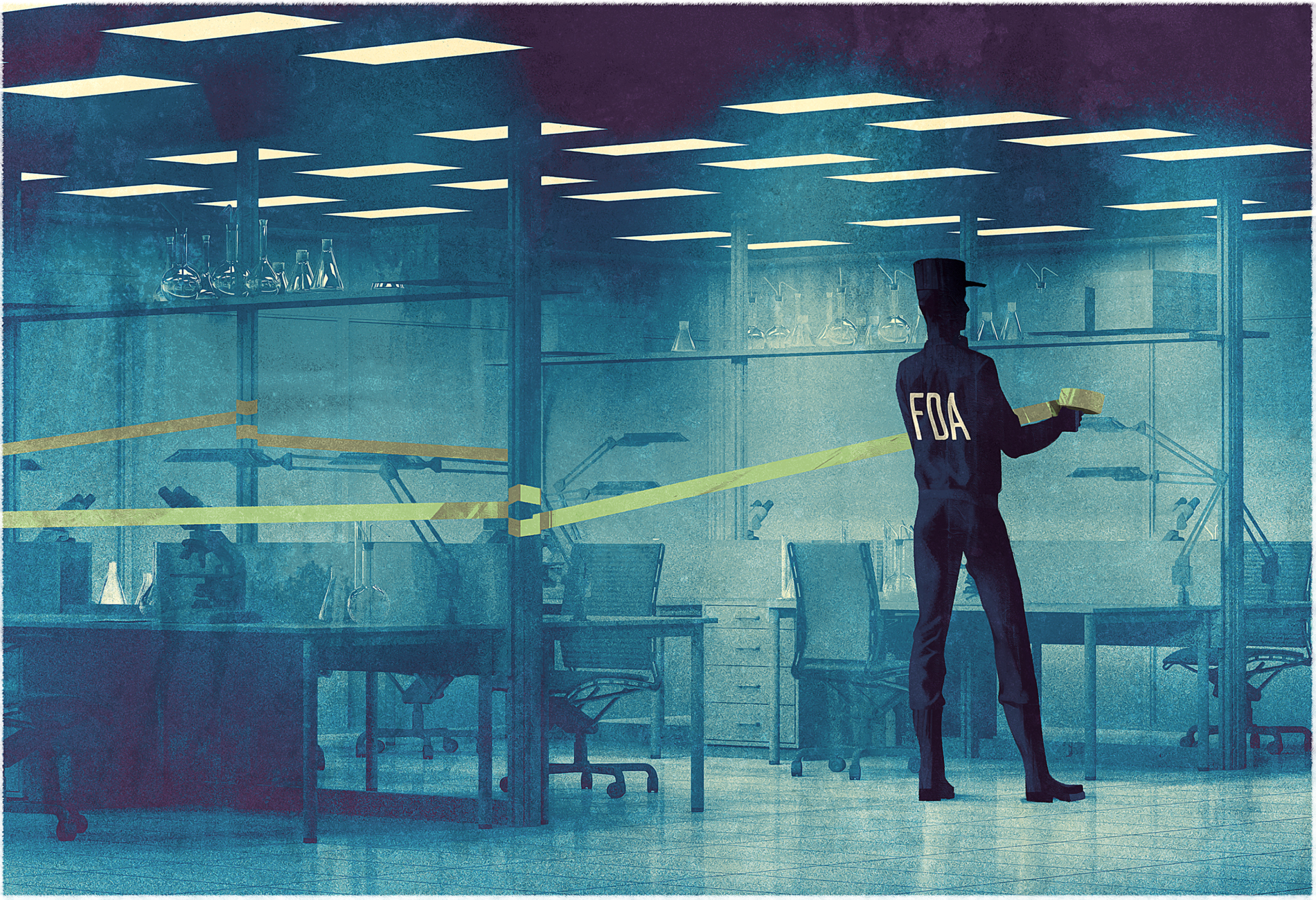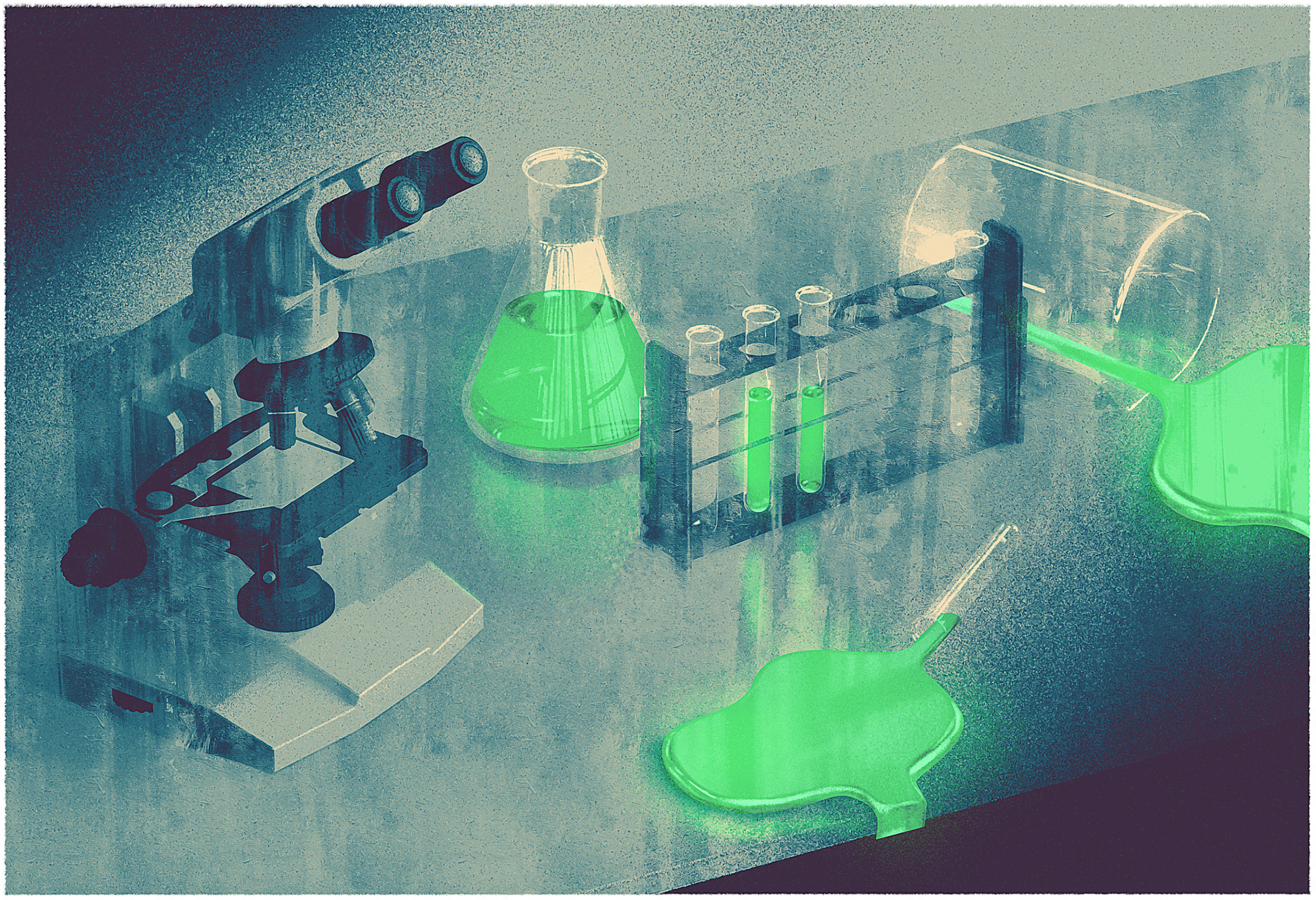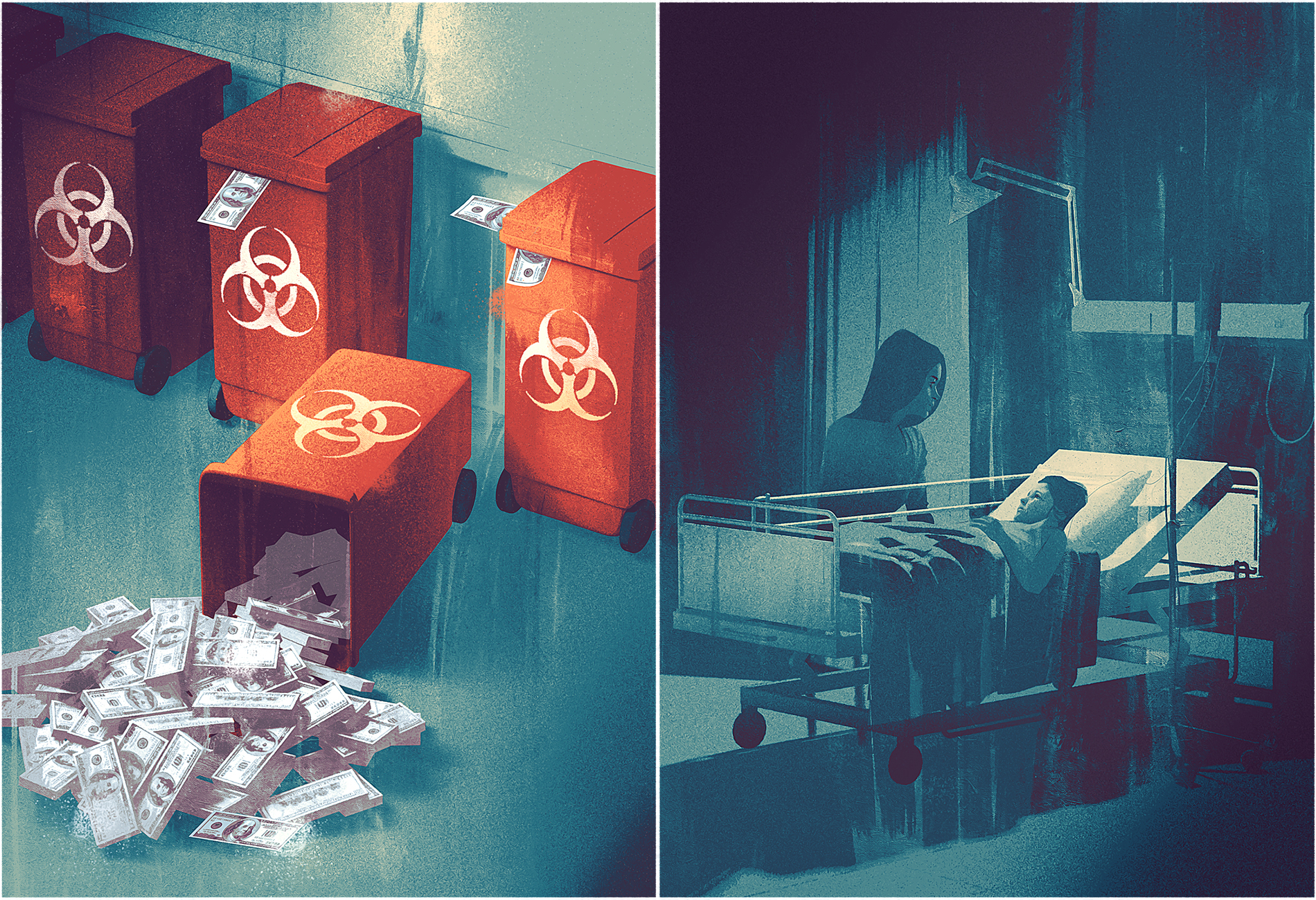
False hope for autism in the stem-cell underground
Parents of autistic children are paying tens of thousands of dollars for stem cell therapies that often use medical waste. Despite the risks, regulators have been slow to act.
I
n July 2017, Jodi Kaufman Perskin spotted an intriguing post in a newly formed Facebook group where parents share advice on stem cell therapy for children with special needs. She had joined the group looking for help for her teenage son Jason, who has autism.In the post, pediatric surgeon Thom Lobe introduced himself and included a link to Regenevéda, his chain of ‘regenerative medicine’ clinics in Beverly Hills, New York and Chicago. Lobe’s profile picture shows a bald man in his 60s with a white goatee and a surprisingly youthful complexion. His clinics focus on wellness and anti-aging treatments but also offer stem cell therapy for autistic children. “I’d be happy to provide my services and knowledge as a resource for you and answer any questions that come my way,” Lobe wrote.
Jason lives in New Jersey. Lobe’s primary practice is in Chicago, but Jason’s father had taken him farther for stem cell treatments before. In 2015, he and Jason had flown to a clinic in Panama and, later, Mexico for stem cell treatments costing about $15,000 each. In Mexico, Jason was put under light sedation so that stem cells could be withdrawn from his hip bone and injected into his spine. After that treatment, Jason’s language ability clearly improved, Perskin says, but she disliked that the procedure required sedation.
Lobe’s method, by contrast, sprayed donor cells up the nose or injected them into the bloodstream. This approach seemed safer to Perskin. Lobe, too, seemed more trustworthy than the chiropractors she had heard were offering the procedure. “He’s a surgeon, and I feel more comfortable with him,” she says.
A month after Lobe’s Facebook post, Perskin and her husband took Jason to see him. “Jason did awesome in Chicago with stem cells today,” she posted in the group in August 2017. “So far, no side effects.” Lobe recommended the Perskins bring Jason four times a year, at a cost of $8,500 per visit. Perskin says she didn’t want to “overload” Jason’s body and decided to take him only twice per year.
Many parents of autistic children are, like the Perskins, turning to social media to exchange information on stem cell clinics, which have proliferated in the United States and abroad over the past few years. These forums play down the fact that only a small fraction of stem cell treatments — specifically, those for generating blood cells — have been proven safe and effective in the eyes of the U.S. Food and Drug Administration (FDA).
“Human suffering plays a role in driving this marketplace,” says Leigh Turner, a bioethicist at the University of Minnesota in Minneapolis. As of May 2017, at least 432 companies run 716 stem cell clinics in the U.S., marketing treatments directly to consumers via the internet, according to a database maintained by Turner. Only 13 of those companies made claims related to autism, but interest in the area has been growing, Turner says — in part thanks to a high-profile, ongoing clinical trial at Duke University in Durham, North Carolina.
One Facebook group, called “Stem Cells for Autism 2.0,” has attracted 3,600 members since it launched in March 2018. “The consensus among parents is that it’s scarier not to do anything,” says its founder, Susan, who compiled a secret list of 15 U.S. doctors who offer stem cell infusions to autistic children like her son. (We have withheld Susan’s last name to protect her privacy.) She compares her efforts to those of the “Dallas Buyers Club,” the underground group of HIV-positive people who smuggled unapproved drugs into the country in the 1980s.
Despite the approach’s popularity, the FDA has been slow to act. The agency warned consumers in November 2017 that the treatments may be “illegal and potentially harmful” and announced plans to tighten its rules in 2020. Until then, however, its primary strategy is ‘enforcement discretion.’ The FDA has sent formal warning letters to 4 companies over the past year or so, while urging 20 more to “engage with the agency.” Some state regulators and other agencies have picked up the slack. In October, a California doctor who promised to “reverse autism symptoms” agreed to pay a $525,000 settlement to the Federal Trade Commission over charges of deceptive health claims.
Meanwhile, many other doctors, like Lobe, continue to market stem cell treatments for autism. “I find it astonishing that this marketplace exists as a result of regulatory inaction,” Turner says.

From hope to hype:
S
cientific interest in stem cell therapies for autism began from one doctor’s observation.In the late 1980s, Joanne Kurtzberg, a pediatrician specializing in blood cancers, worked with Hal Broxmeyer, who had been studying the stem cells present in blood from umbilical cords preserved at birth. Since the 1950s, doctors have treated blood cancers using transplants of bone marrow, which contains adult stem cells capable of generating blood cells. But as Broxmeyer’s group showed, cord-blood stem cells are more potent than adult stem cells at this task. Of particular value, they do not require a perfect ‘match’ between donor and recipient.
Kurtzberg recognized the promise of cord blood for people of color, who often have trouble finding matching bone-marrow donors. So, in 1998, she founded the Carolinas Cord Blood Bank at Duke University and, in 2005, helped pass legislation to establish a national network of similar banks. Every year in the U.S., about 200,000 women donate cord blood from their babies to these public banks or to research labs; families also pay to store up to 7 million units of cord blood in private banks worldwide, though these samples rarely end up being used. In 2011, the FDA began requiring companies selling therapies developed from cord blood to submit data showing their safety and effectiveness.
In the late 1990s, Kurtzberg says she noticed something curious following cord blood transplants in children with certain metabolic conditions who also have autism traits. The transplants not only extended their lives but also seemed to prevent brain deterioration and improve brain function. Kurtzberg theorized that the stem cells in the cord blood might be engrafting in the brain and repairing damaged tissue. Other cells in the cord blood might also be sending chemical signals across the blood-brain barrier to lower inflammation, which is seen in some people with autism, she says.
To test the inflammation theory, Kurtzberg began collaborating with Geraldine Dawson, an autism researcher also at Duke. In 2014, they launched a clinical trial with $40 million in funding from the Marcus Foundation, a nonprofit based in Atlanta that supports a variety of causes. The foundation’s head, Home Depot co-founder Bernie Marcus, has called himself “a real advocate for stem cells” for autism, and he reportedly told the controversial leader of the Panama stem cell clinic the Perskins visited that he hoped to get approval from the FDA.
The Duke trial drew immediate criticism. In 2014, Arnold Kriegstein, a neural stem cell expert at the University of California, San Francisco, told Spectrum the study was a “Hail Mary pass” and that it was unlikely cord-blood stem cells could reverse autism-related changes to the brain during early development. “None of their explanations hold water on why it would have any therapeutic value,” Kriegstein now says. Paul Knoepfler, a researcher at the University of California, Davis who blogs about the stem cell industry, also expressed skepticism, noting that autism’s causes are too diverse and mysterious for the therapy to make sense.
Still, the Duke team published encouraging results from the safety phase of the trial in 2017. Clinicians working with the researchers evaluated 22 of the participants, all between the ages of 2 and 5 years, and documented improvements in 13 of them six months after a single infusion. Without a control group, it is impossible to say whether the children would have improved anyway. A follow-up report found that those who improved showed increased connectivity in brain regions affected by autism, including the limbic system, but the researchers published no evidence to support their inflammation theory.
Because there were no adverse effects from the infusions, in November 2017 the FDA granted Kurtzberg special approval to provide cord blood infusions to certain children, including some with autism. Kurtzberg declined to say how much the treatments cost but confirmed that the parents from other countries are required to put down a $15,000 deposit; the money covers a 45-minute intravenous infusion of their child’s own cord blood or that of a matched sibling. Kurtzberg says her team plans to treat about 1,000 children per year, and that they have a waiting list of more than a year. She expects to publish the results of a placebo-controlled phase of the trial sometime this year, comparing children who receive cord blood infusions with those who do not.
While the Duke trial pushes forward, others have sputtered. A 2018 clinical trial at the Sutter Institute of Medical Research in Sacramento, California, found “minimal evidence of clinical effectiveness” of cord blood infusions given to 29 autistic children. The National Institutes of Health clinical trials registry lists 11 other autism-related stem cell trials — but 3 concluded years ago without registering any results, 3 are listed with an ‘unknown’ status, and 2 have been withdrawn. Most are outside the U.S., and none randomized the participants to receive the therapy or placebo, which is considered the gold-standard approach in clinical trials. Some may even be ‘pay-to-participate’ trials, which are little more than marketing ploys to lure customers, Turner says.
Kurtzberg acknowledges that her research has led to a boom in questionable stem cell providers but says her team members do their best to tell families to tread carefully. “We don’t want to promote a therapy that’s not helpful,” she says.
”“Human suffering plays a role in driving this marketplace.” Leigh Turner
Regenerative profits:
T
hom Lobe echoed a similar sentiment in May at the annual AutismOne Conference, which has long showcased the outermost fringes of alternative medicine. Funded by philanthropist Barry Segal, a businessman with an anti-vaccine bent, the conference’s regular speakers include actress and activist Jenny McCarthy and disgraced former doctor Andrew Wakefield.Some speakers argued that vaccines are a tool for genocide; others explored the ‘quantum physics’ of autism. Lobe described the Duke trial and how cord blood might help people with autism. “Is stem cell therapy a good choice for your child today?” he asked the audience. “Really, only you can determine that. That ends up being a personal question. I think as you go look for treatment centers, you should be careful who you choose.”
Lobe told Spectrum he first became interested in the potential of stem cell products to slow aging about a decade ago. At the time, he had just opened his first alternative medicine clinic, Beneveda Medical Group, in Beverly Hills, California, and had run into financial trouble. In 2010, that clinic lost more than $200,000, according to court records. Lobe also owed money from a malpractice claim related to his surgery practice, plus more than $500,000 in personal business loans. By the time he declared bankruptcy in July 2011 and shut down the clinic, he and his business had amassed nearly $5 million in potential debt claims.
Within a few months, however, Lobe opened the Regenevéda Wellness Clinic, just a five-minute drive from his old clinic. Out went the freelance shamans and chiropractors; in came electromagnetic impotence treatments, shockwave therapy and stem cells. He soon moved his clinic to Chicago and established consulting offices in Beverly Hills and New York. He has also assigned an employee to coordinate with clients seeking help for neurocognitive conditions, including autism.
Lobe initially obtained the cord blood for his clinics from several companies, including Liveyon in Yorba Linda, California, which sells it for about $2,000 for a thimbleful.
That company’s executives were also new to the stem cell business. Liveyon’s director of medical education, for example, is Alan Gaveck, a former podiatrist who had his Arizona license placed on probation in 2008 after a surgery he performed resulted in a schoolteacher losing her toe. “Sometimes things just go south,” Gaveck says, insisting he provided the best possible medical care. The company’s chief executive, John W. Kosolcharoen, left the financial services industry in 2014, after he had reached a settlement with the Securities and Exchange Commission. The settlement covered allegations that he had acted as a sales agent for a business the U.S. Department of Justice described as a Ponzi scheme. He founded Liveyon two years later, during the same month he was arraigned on federal charges of healthcare fraud related to another business. “You can’t even imagine the scrutiny I have to go through trying to operate a company with that type of background,” Kosolcharoen says.
Liveyon didn’t have its own lab but purchased cord blood for its products from a company called Genetech, Inc., based in San Diego. Genetech’s founder and president, Edwin Pinos, had also seen a chance to regenerate his career in the stem cell arena. In the early 2000s, Pinos managed an upscale seafood restaurant in Irvine, California, and then entered the mortgage business. During his ascent, he collected a string of charges and convictions for driving drunk, grand theft auto, identity theft and other felonies, including a swindle that roped in Alan Gutcheon, a mortgage broker in Newport Beach, California. “He was a great confidence man,” Gutcheon says of Pinos. “He preys on those that are stupid; I must be stupid.” (Pinos did not respond to multiple emails and phone calls.)
After the police issued an arrest warrant for Pinos in 2016, Gutcheon figured Pinos would be locked away for a long time. But then Pinos called him, Gutcheon says, promising to pay him back, and told Gutcheon he had found a new career — one in which felony convictions evidently posed no obstacle.
Pinos filled out a short form on the FDA’s website, registering Genetech as a human tissue bank. Like other tissue vendors, he inked deals directly with local hospitals or with middlemen to cart away birth waste from new mothers — clamped umbilical cords that could be processed and rebranded as ‘stem cells.’

Cell sale:
Many of the largest cord-blood banks are members of the nonprofit Cord Blood Association, which is led by Kurtzberg and requires third-party accreditation. These banks, along with manufacturers of FDA-approved cord-blood therapies, such as Hemacord, meet stringent requirements for handling the tissue, ensuring its viability and screening for viruses and other pathogens. By contrast, companies such as Genetech and Liveyon that are selling to so-called stem cell clinics are operating under FDA rules largely meant for dead tissue, such as a tendon or a hunk of bone, even though the implied benefits of their products derive from living stem cells.
An analysis of nine products derived from cord blood and other birth tissue, presented at a conference in February, found that not one contained a single living cell. Liveyon’s own white paper from 2017 reported that only about 60 percent of the cells in their product were alive, compared with 90 percent from accredited cord banks. But Liveyon didn’t perform all the tests needed to demonstrate that those cells were live stem cells, says orthopedic surgeon Christopher Centeno. Centeno’s company once ran afoul of the FDA in connection with its experimental stem cell therapies, but he has since become something of an industry watchdog. “There really are no umbilical cord stem cells in existence outside universities or cord banks,” he says.
Pinos apparently didn’t let that uncomfortable fact get in the way of his success. In 2018, he posted pictures on Facebook of a dinner party at a $5 million home on the Orange County coast and quoted the classic Johnny Nash song in a caption: “I can see clearly now, the rain is gone … It’s gonna be a bright (bright), bright (bright) Sun-Shiny day.” Liveyon, meanwhile, began advertising on its website and via social media a “Stem Cell Mastermind Summit” to teach doctors how to “build a 7- to 8-figure stem cell practice with Liveyon” while staying “in the FDA’s good graces.”
Then, in June 2018, a veteran FDA inspector named Tania Hall showed up at Genetech’s laboratory and spent five days going through their records. She soon found that the company had placed no restrictions on who was eligible to donate tissue and had not screened specimens for HIV, hepatitis or Zika virus, as required by law. The company also had no way to trace a contaminated vial of stem cells back to a donor, nor was its lab work conducted under sterile conditions. In a warning letter the FDA later sent Pinos, the agency alleged that he was breaking the law by marketing the stem cells as a therapy. The letter made clear there was “a significant risk that your products may be contaminated with microorganisms or have other serious product quality defects.”
Jim Hardy, a biochemist who took an unpaid role as Genetech’s chief compliance officer in its early months, says he tried to explain to Pinos that the cord blood Pinos was selling to Liveyon was only good for research purposes. “They didn’t have any basic quality systems in place,” Hardy says. He parted ways with the company when Pinos stopped responding to his emails. “[Pinos] and I didn’t see eye to eye,” Hardy says.
Pinos responded to the FDA’s warning letter by promising to correct the violations and offering to fill out a few sample forms he provided. The agency’s reply was tepid. “We recommend that you review the deviations listed above, consider the potential serious risks to patients your manufacturing violations present, and consult with third-party experts to implement comprehensive corrective action,” the FDA said in its response.
What happened next would hardly come as a surprise to critics of the stem cell industry. On 12 September, Galen Dinning, an 82-year old Texan man suffering from chronic pain, went to a chiropractor’s office for an injection of one of Liveyon’s stem cell products. A couple of days later, Dinning began experiencing a throbbing pain in his neck and showed up at the local hospital with a high fever. He was flown to Houston, where doctors discovered the pathogen Enterobacter cloacae coursing through his blood. Dinning had a heart attack while he was in the hospital, but he recovered and was released after 10 days.
Another person who visited the same clinic developed an abscess at the injection site on her spine. A third lost control of her hands and feet when a blood infection led to kidney failure.
Soon, reports trickled in of more Liveyon customers in Texas, Florida and Arizona falling seriously ill. An analysis of unopened vials by the Centers for Disease Control and Prevention confirmed the presence of multiple bacteria, including E. coli, and Liveyon issued a voluntary recall. Hartley Hampton, a lawyer who represents six Texas clients, says any doctor calling these products stem cells is a “giant fraud.” He says: “It’s basically just a bunch of afterbirth run through a blender.”
There were no reports of anyone with autism being affected by the contaminated products, but Perskin’s Facebook group took notice. “Does anyone have more info on the recent recall of Liveyon cells?” one mother asked in a post in October. Lobe chimed in. “I just spoke with a Liveyon representative,” he wrote. “There are no contaminated vials or bad lots. One of Liveyon’s suppliers lost its accreditation from the FDA so Liveyon is voluntarily replacing all the existing vials with product from other suppliers.” He said the recall was just a precaution. “It could simply be that the FDA is targeting Liveyon because their marketing is successful,” he suggested.
Liveyon and prosper:
A
lthough the risk of contaminated cord blood shows the most extreme dangers that lurk in the stem cell marketplace, there could be other unwanted consequences, even with sterile products. The most serious may be that parents take their child for multiple infusions from multiple donors, Kurtzberg says. Doing so increases the chances that the child will develop antibodies against the foreign cells, which can lead to rejections of future tissue transplants or autoimmune conditions. “I would not do that with my patient, my child or myself,” she says.Kurtzberg says she has measured antibody levels rising in her clinical trial participants after a single infusion. To lower the risk of children developing antibodies in an upcoming study involving multiple infusions, she plans to use cells cultured from umbilical cord tissue from a single donor. Commercial stem cell companies, however, are forbidden from culturing cells without FDA approval.
Lobe, meanwhile, remains a true believer. He says he has seen no adverse results with any products he has used so far but warns his clients that the therapy is experimental and may have unforeseen risks. “All of this is made very clear to them,” he says.
In the aftermath of the Liveyon recall, Lobe started sourcing his umbilical cord blood from another California-based company, called Stemell. “I only choose sources that are U.S.-based, procure cells from U.S. patients who are screened by U.S. labs for any risk of infection or disease transmission and which collect, test, process and distribute products they make in-house,” he told Spectrum.
Stemell’s website previously showed a badge from the Cord Blood Association, but Alan Leahigh, the association’s chief executive, says Stemell has never been a member. Following an inquiry from Spectrum, he demanded in December that the website take down the badge.
Stemell was founded by a cellular biologist named Peyman Taeidi two years after he filed for personal bankruptcy. Taeidi says he doesn’t make any claims about what his products can be used for but is aware that some doctors are using them in infusions given to autistic children. “They receive great gains and are very happy,” he says of the families.
These days, Pinos’ Facebook page has gone dark. His brother Edizon says he is in Costa Rica. And Genetech no longer appears to be in business: It has moved out of its shared lab space and has not responded to the lawsuits filed in Texas.
Liveyon’s chief executive, Kosolcharoen, says the company plans to sue Pinos for providing bogus lab reports and that he has provided a statement to the U.S. attorney’s office for the Southern District of California in San Diego. Liveyon has entered into a partnership with the World Stem Cells Clinic in Cancun, Mexico, which Kosolcharoen calls a “world-class center for autism.” In preparation for the March launch of the first stem cell product made in-house by Liveyon Labs — billed as “the first clinical-trial-grade cell product in the U.S.A.” — a billionaire friend of Kosolcharoen offered up his Beverly Hills mansion for a celebration.
On Facebook, Kosolcharoen posted a photo of himself at the house next to a gleaming Rolls Royce. “When life gives you ????’s,” he wrote, “find a big ass house to make Lemonade ???????? #StemCells.”

Syndication
This article was republished in Slate.
Recommended reading

Expediting clinical trials for profound autism: Q&A with Matthew State

Too much or too little brain synchrony may underlie autism subtypes
Explore more from The Transmitter

Mitochondrial ‘landscape’ shifts across human brain

